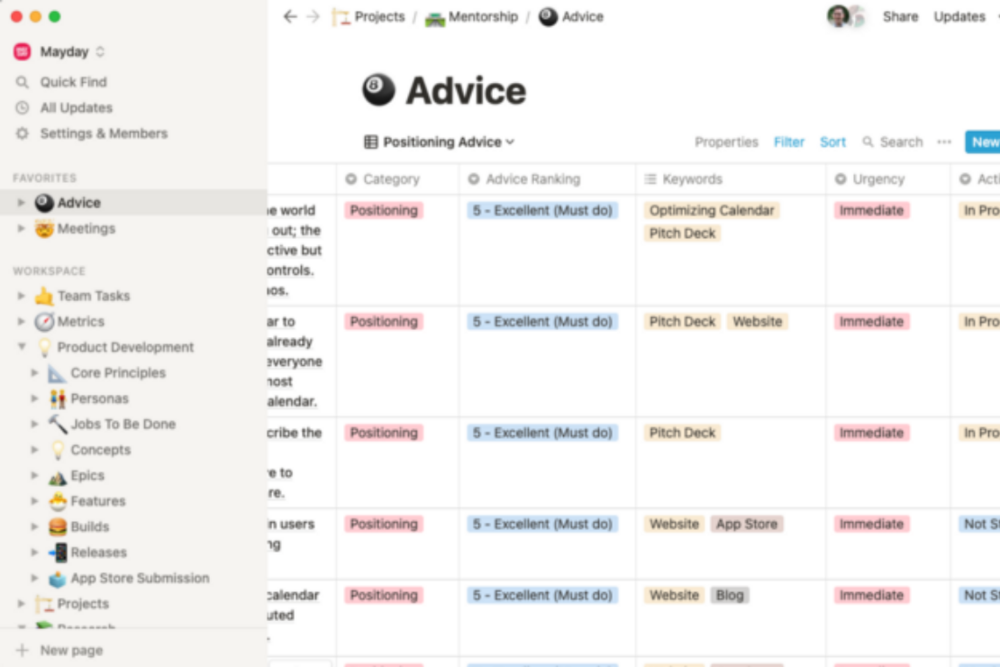Easier Said Than Done: A Framework for Prioritizing Advice
Mar 22, 2021

When Mayday went through the 2020 Techstars Toronto Accelerator, cofounder and COO Adam Day and his team had 80 conversations with mentors over four weeks — and got a huge amount of advice. In this article, Adam details how he managed this excess of advice and turned it into action items for now and later.
It’s okay to acknowledge that you don’t don’t have all the answers. Especially when you’re doing something as ambiguous as building a startup. The expansive possibility is also expansive unknown. And you need to move quickly in uncharted areas if you want to succeed.
Learning from your own mistakes is one approach, but it’s expensive and it can sometimes mean life or death to an early-stage company. A better solution, is to ask for help and to seek advice.
Unfortunately, obtaining advice can be more complicated than it seems. Seek too little advice and you risk making avoidable mistakes. Seek too much advice and you risk being overwhelmed with suggestions. Advice needs a system for prioritization in order to actually be useful.
For most startups, or in our case more specifically — when building a consumer-oriented internet product — there is no shortage of available advice. We get advice on what we’re planning to build next, advice on how we’re going to acquire users, advice on how we’re going talk about what we do, advice on how to raise money, etc. etc. etc. Further complicating matters, there’s a temptation to demonstrate that you can do it all. But in trying to focus on everything, you risk getting nothing actually done.
This challenge became most apparent while we went through Techstars Toronto last summer. During the first month of Techstars, you meet with new mentors every week for four weeks straight. In total you end up having upwards of 80 conversations about your business over an extremely short period of time. This yields many, many discrete pieces of advice. So we developed system in Notion (see template linked below) that enabled Mayday to become a advice prioritization machine. Here’s how we do it:
Step 1: Recognize Advice
In a past life, giving advice to startups was a regular part of my job. You make a few observations, evaluate the situation relative to your own experiences, make your best guess, and move on with your life. It’s generally pretty easy to feel like you’re adding value.
If a mentor gives good advice, they can benefit in a number of possible ways (i.e. opportunities from a reputational standpoint, career standpoint, investment standpoint, etc.). If a mentor gives bad advice, there’s a bit of a survivorship bias at play — we’re wired to forget the failures — and so generally it doesn’t matter too much.
As a result, “advice” is cheap and plentiful. This means that the ability to recognize “advice” when you see it is critical. I put the word “advice” in quotations because there’s a distinction to be made between advice and opinion. Everyone can offer opinions, but not everyone can offer advice.
Advice is a recommendation based on what someone knows.
Opinion is a recommendation based on what someone thinks.
Recommendations founded on experience are inherently the most valuable. They are backed by evidence and build on what has worked well and what has failed for others in the past.
This isn’t to say that opinions are worthless, but that being able to identify advice based on experience rather than intuition can be a super efficient way to de-risk and prioritize decisions.
But identifying feedback based on experience requires extensive background research and diligence. It goes without saying that you should research the backgrounds of people that are offering you mentorship, but this should involve more than a brief glance at their LinkedIn profile while you search for the right conference URL.
Diversify the sources of your information and go deeper to find out how much money they’ve raised, which portfolio companies they’ve worked with, and generally, what is their specific area of expertise. If you can figure out what someone knows from experience, you can better assess out what to consider seriously.
Step 2: Recognize Good Advice
In addition to credibility based on experience, there are two other major factors to consider when gauging the quality of advice: whether it is actionable, and whether it is timely.
Actionable advice focuses on things that you can control and decisions to be made. Instead making general observations, actionable advice (rather obviously) focuses on the actions that you can take.
Seek out mentors who don’t just identify problems but who can also help find solutions. Alternatively, don’t let conversations end on the identification of a problem — probe further to seek out potential solutions. Drive the conversation until you obtain actionable advice.
Timely advice not only focuses on things you can do right now (or at least in the short term), but it is also based on the state of things today. Given how fast circumstances evolve in an early-stage setting, advice that makes sense today may be completely irrelevant in a matter of weeks.
This isn’t to say that you should avoid conversations around your long term strategy, but that you should aim to focus on short term actions that will get you towards your ideal future outcome.
Step 3: Categorize Advice
Steps 1 and 2 enable you to take multiple conversations and to distill these conversations into lots of high value, actionable and timely advice. But you already have a list of a thousand other things to be working on, so how do you make prioritize anything realistically? By organizing the data!
A quick aside on building a startup — arguably the most important goal for any early stage venture is to achieve Product-Market-Fit. There’s a ton of literature out there on what Product-Market-Fit is and how to achieve it. My favorite way to think about Product-Market-Fit is that it’s the point within a company’s trajectory when every time you encounter your target customer, you can confidently expect that they will buy your product. It’s the stage at which you understand exactly who the target is, and you can offer them a product that is so finely tuned to satisfying their needs that they have no choice but to pay you money. This is the dream.
Generally speaking, any early-stage startup can expect the majority of the advice received to focus on how to achieve and build on Product-Market-Fit. More specifically, Product-Market-Fit advice covers four different categories:
Product — how to improve your solution
Go-to-Market — how to deliver your solution
Positioning — how to articulate why your solution is THE solution
Fundraising — how to capitalize on your solution
Each of these four categories warrants its own strategy, so separate advice as it comes in and evaluate the advice in each category as a group.
Step 4: Identify Patterns in the Advice
In many cases, different advice from different people will be contradictory. As an example in our case, we’ve received an enormous variety of advice on when to target the enterprise use-case for Mayday. You may also find yourself in a situation where you receive some advice to begin pilot conversations with enterprise clients, and some advice to focus on a bottoms-up approach that will grow from the grassroots into a workplace setting. Both are good options, but you can’t do both well at the same time. Here’s where you have to use some of your own judgement based on broader patterns in the feedback.
To simplify, it’s best to first look for patterns — using a keyword tagging system with your database of advice helps here. In our case we made lots of keywords to filter for advice that touched on our website, on benchmarking with competitors, on email campaigns, etc., and sorted the data to look for trends.
Your goal should be to cluster similar themes of advice around each other and to identify signals in the noise. This doesn’t mean that you should ignore outlier advice, but instead to layer your own experience and judgement into the picture in order to determine what makes sense for your company today. Triangulate all of the best feedback around recurring themes and critically assess how the diversity of opinions diverges from your own thinking.
Step 5: Prioritize Advice and Take Action
After you have a good sense of the patterns in the feedback, you can prioritize more effectively. Now is the time to weigh in other considerations around your team’s capacity, your resources, and your vision.
To practically prioritize, we find it helpful to use a 5 point scale:
5 — Excellent (Must do)
4 — Great (Will likely do)
3 — Average (Will consider)
2 — Just OK (Second opinion required)
1 — Bad (Will not do) *hopefully you’re not building a database with a lot of this advice
In our case, we also prioritize the best feedback using three time horizons that reflect urgency: (1) immediate action, (2) short term action, and (3) medium term action. Anything immediate we aim to achieve within the next month, anything short term is intended to be achieved within the next 3 months, and anything medium term is intended to be achieved within the next 6 months. From here, it’s just a matter of execution — tasking things out and measuring success.
A Template for Prioritizing Advice in Notion
Notion is the real workhorse for our operations at Mayday. We use it to bring together our product roadmapping, sprint planning, task management, user research, and even our CRM. This enables us to create a lot of useful linkages throughout our process. Mentors in our CRM are linked to raw meeting notes, which are linked to a database of advice, which is categorized and prioritized and linked to epics/features/tasks.

Not only does this practice allow us to easily identify where concepts originated as our business evolves, but it also enables us to come prepared any time we meet again with a mentor in the future (by giving us the ability to recall the key takeaways from our previous interactions and to demonstrate our progress).
I’ve created a Notion Template for Prioritizing Advice that can be copied and integrated into your own workflow. It demonstrates the linkages that can be made between your meeting notes, CRM, and team tasks. To use it in practice: (1) Populate your CRM, (2) Create a record for each Meeting you take — link it to your CRM, (3) Process your takeaways from the conversation into Advice, (4) Create a record for each piece of Advice — link it to your Meeting, (5) Create Tasks for you and your team — link it to each piece of Advice.
Whether it’s built in Notion, in Google Sheets, or some other platform doesn’t really matter. What’s important is that you take each piece of advice with a grain of salt and don’t waste the opportunity to build on the insights of others. At the end of the day, you are the one that will decide what you do and what you don’t do. Use a system and prioritize thoughtfully.
This article originally appeared on Medium.
About the Author

Adam Day
Adam Day is cofounder and COO at Mayday, a smart calendar assistant that gives you control of your schedule and helps you spend time in more meaningful ways. Previously he built and scaled the AI program at a Toronto-based startup accelerator and has held a variety of technical roles in aerospace engineering and R&D. He has an MBA from the University of Toronto and an engineering degree from the University of Western Ontario. Follow him on Twitter @adamday6
